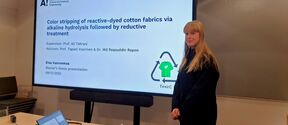Will artificial intelligence take your job in marketing? True or false: five claims about the future of marketing

1. The development of analytics will revolutionise the entire marketing sector
TRUE AND FALSE. Analytical methods evolve constantly, and especially AI-based solutions are broadening marketers’ toolboxes. This not only requires new technical skills from marketing professionals, but also calls for a greater ability to utilise diverse types of information in decision-making. Repeated, routine marketing activities are increasingly becoming automated, whereas needs for higher-level expertise in both marketing and data analytics are simultaneously growing.
Essentially, marketing knowhow continues to be about understanding customer needs – along with understanding the firm’s and its competitors’ ability to fulfil those needs both now and in the future. These understandings are often industry-specific and (at least partly) based on experience and cannot be replaced by - only supported with - technical tools.
It is also good to remember that even the most advanced analytics and automation require interpretation, continuous monitoring and updating, as well as periodic redefinition, in which the role of marketing professionals remains vital. The evolution of tools may, however, lead to altering job descriptions and increasing needs for particularly higher-level expertise in marketing.
2. Advanced analytics is a privilege reserved for large firms
FALSE. Larger firms naturally have more resources for collecting and analysing data as well as adopting new methods and technologies. Still, many analytical tools can be tested even with smaller investments and are becoming increasingly accessible and easy to use.
Firms don’t have to do everything by themselves, either. Considering our ongoing research, analytical capabilities shared in business networks may prove to be an even surprisingly important source of competitive advantage. Along with the increase of tools, the range of analytics-focused service providers is also growing. This increases opportunities for outsourcing analytics-related functions to external service providers.
3. All firms need to invest in analytics
TRUE AND FALSE. As the utilisation of analytical tools and data becomes more common in different decision-making situations, its role easily evolves from a source of competitive advantage to a hygiene factor: the advantage disappears, but it is no longer possible to thrive without. This is why no firm can afford to ignore its development.
There are, however, many types of analytics and analytical capabilities. When we examined the ways in which Finnish companies utilise analytics in their marketing decisions, we identified two main streams: use of analytics to build strategic understandings of customers and their behavior, as well as use of analytics for optimizing tactical marketing communications. The former has a significantly larger impact on marketing performance. This finding emphasises a need for individual firms to carefully identify the types of analytics and analytical skills that are particularly useful for their specific business and environment.
At the same time, it is important to maintain a healthy criticism towards the continuously expanding offering of analytical tools. Not everything needs to be adopted at once. It is also important to monitor the returns of investments in analytics themselves - to develop ‘metrics for metrics’ - to ensure that any investments to analytics actually benefit the business.
4. The greatest challenge for Finnish firms is to keep up with the evolving technology
FALSE. Finland as a traditional ‘engineering country’ has plenty of technological expertise. At the same time, analytical tools are becoming increasingly accessible and easy to use.
Combining technological skills with a market-oriented approach is what often proves more challenging. Analysts, data engineers and marketing decision-makers often come with very different educational and competence backgrounds and therefore have very different perspectives to business. We strive to mitigate such bottlenecks by offering several courses focusing on analytics in the School of Business’s marketing curriculum.
5. Consumers must also stay alert
TRUE. Advanced marketing analytics help introduce products and services that better meet consumers’ needs; improve consumers’ access to those offerings; better target marketing communications; and thereby enhance consumers’ life and wellbeing. However, this is not without costs: improvements in service are often based on increasingly comprehensive information of customers and consumers, often at the expense of their privacy. Every purchase, visit, contact, search, click and like that we as consumers make in our daily activities get recorded in the databases of various service providers. Furthermore, these databases increasingly often link to each other, resulting in increasingly detailed illustrations of our lifestyles, values, and preferences.
It is, of course, up to each individual to decide what to prioritize. It is important, however, that any tradeoffs regarding privacy are made by conscious choice, and that the recording and utilisation of data by different parties would not come as a surprise.

Department of Marketing
The Department of Marketing is a thriving and dynamic community of faculty, researchers, staff, and students. The department has earned international acclaim for its ambitious and rigorous research output. We are at the bleeding edge of marketing.

Read more news

Learning Centre opening hours during Christmas and year-end holidays
Thank you for the past year and have a wonderful holiday season!
Smart textiles are reshaping our understanding of materials – and interspecies communication
The PAST-A-BOT research project, funded by the European Research Council (ERC), is developing soft, intelligent textiles that could one day function as rescue robots, sound-sensing agricultural fabrics, or assistive clothing. At the same time, the project aims to rethink the way we approach materials research.
Master’s student showcases efficient color stripping of cotton fabrics
On December 9, master’s thesis student Elsa Vuorenmaa from the Textile Chemistry Group presented the results of her research on color stripping of reactive-dyed cotton fabrics.






